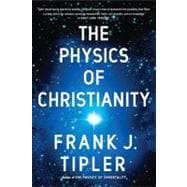
What is included with this book?
FRANK J. TIPLER is a professor of mathematical physics at Tulane University and the author of The Physics of Immortality. He lives in New Orleans, Louisiana.
| Introduction: Christianity as Physics | p. 1 |
| A Brief Outline of Modern Physics | p. 5 |
| Life and the Ultimate Future of the Universe | p. 45 |
| God as the Cosmological Singularity | p. 83 |
| Miracles Do Not Violate Physical Law | p. 101 |
| The Christmas Miracle: The Star of Bethlehem | p. 140 |
| The Virgin Birth of Jesus | p. 154 |
| The Resurrection of Jesus | p. 194 |
| The Grand Christian Miracle: The Incarnation | p. 226 |
| Anti-Semitism Is Anti-Christian | p. 243 |
| The Problem of Evil and Free Will | p. 257 |
| Conclusion | p. 266 |
| Three Christian Creeds | p. 273 |
| Notes | p. 277 |
| Bibliography | p. 293 |
| Index | p. 309 |
| Art Credits | p. 321 |
| Table of Contents provided by Ingram. All Rights Reserved. |
The New copy of this book will include any supplemental materials advertised. Please check the title of the book to determine if it should include any access cards, study guides, lab manuals, CDs, etc.
The Used, Rental and eBook copies of this book are not guaranteed to include any supplemental materials. Typically, only the book itself is included. This is true even if the title states it includes any access cards, study guides, lab manuals, CDs, etc.
Excerpted from The Physics of Christianity by Frank J. Tipler
All rights reserved by the original copyright owners. Excerpts are provided for display purposes only and may not be reproduced, reprinted or distributed without the written permission of the publisher.